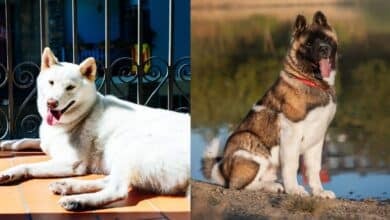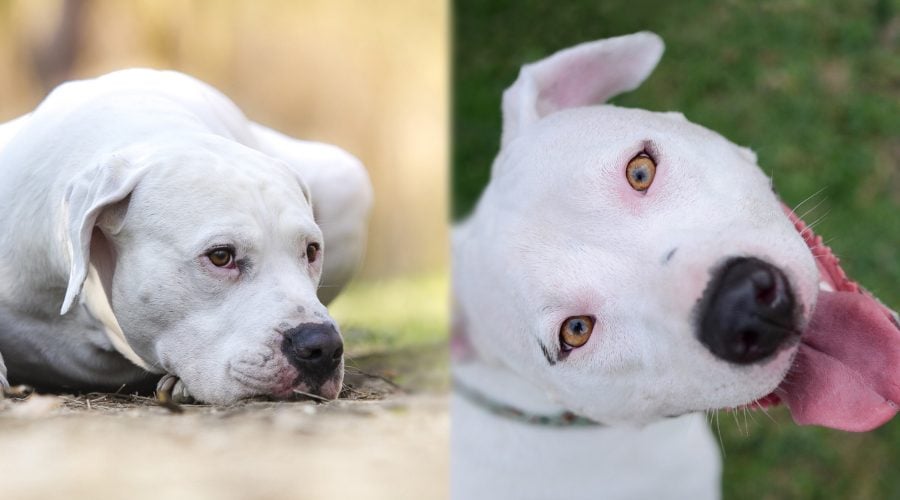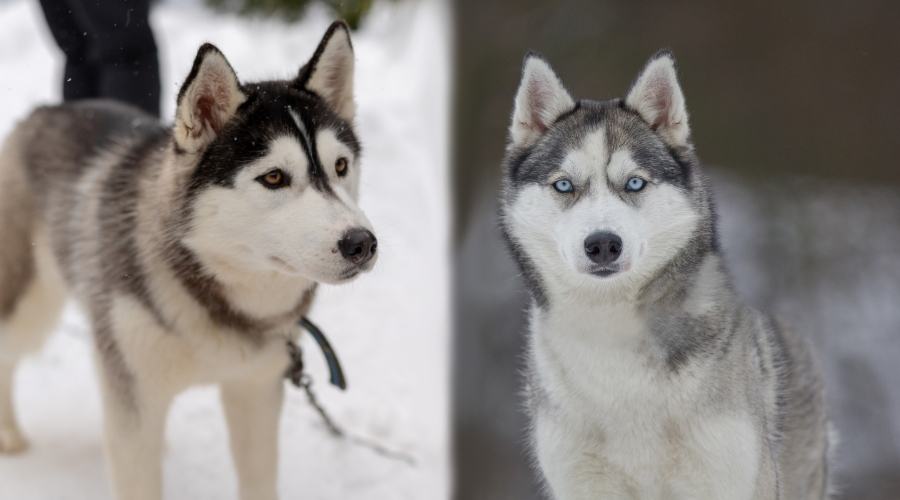Labrador Retriever vs. German Shepherd: Breed Differences & Similarities
When you purchase through links on our site, we may earn a commission. Here’s how it works.
Labrador Retrievers and German Shepherd Dogs are both highly popular as pets. Both make the top of the favorite breed charts year after year. These two breeds have some similarities and some significant differences. If you are considering the Labrador Retriever vs. German Shepherd as your next family pet, there are a few things to know about each breed first.
Table of Contents
Both breeds are similar in that they are both from working backgrounds, one from the hunting world and the other from the protection sector. They are both incredibly intelligent dogs with a lot of energy, so they must be exercised and entertained.
Due to their different working backgrounds, they have differing personalities. The German Shepherd is warier around strangers and has guarding tendencies, whereas the Labrador is sociable with both friends and strangers alike. Let’s look closer at the German Shepherd vs. Labrador Retriever and see precisely why these two are the most popular dogs around.
Breed Comparison
- Height21-24 Inches
- Height22-26 Inches
- Weight55-80 Pounds
- Weight50-90 Pounds
- TemperamentEnergetic, Intelligent, Friendly
- TemperamentSmart, Confident, Courageous
- EnergyVery High
- EnergyHigh
- HealthAbove Average
- HealthAverage
- Lifespan12-14 Years
- Lifespan7-10 Years
- Price$1,000 and Up
- Price$1,000 and Up
Key Differences
- German Shepherds are larger and heavier.
- Labrador Retrievers are friendlier.
- German Shepherds are more loyal.
- Labrador Retrievers shed slightly less.
- German Shepherds are harder to train.
- Labrador Retrievers live longer.
- German Shepherds have more energy.
- Labrador Retrievers are healthier.
- German Shepherds are more protective.
- Labradors are quieter but more outgoing.
- German Shepherds bark much more and are louder.
Breed History
These two beloved breeds clearly have something going for them, so let’s look a little more at the histories of the German Shepherd vs. Labrador Retriever.
Labrador Retriever
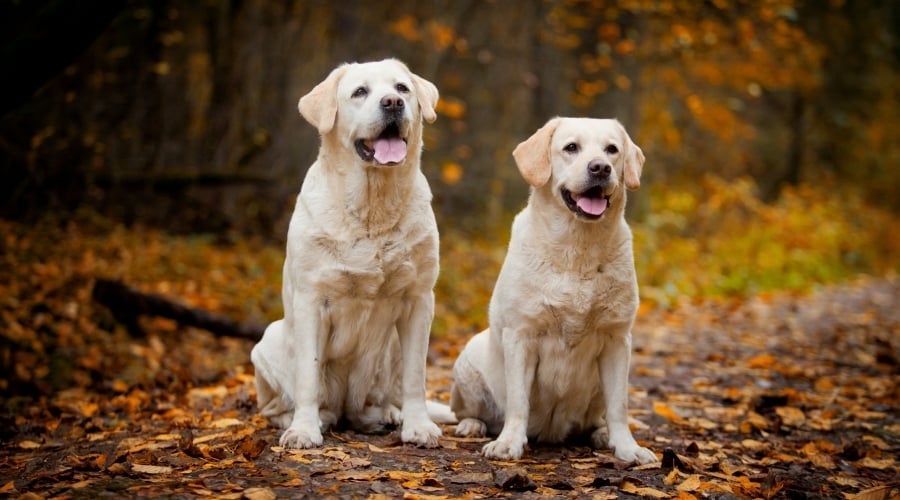
The Labrador Retriever’s journey began in the 19th Century, but he is a Canadian canine. He is from a working background, but more traditionally worked on the water collecting ducks and fish for his fisherman colleague.
When visiting English nobles spotted this fine pup, they sailed him back to Britain and named him the “Labrador Retriever,” but ironically, he is not from Labrador but actually from Newfoundland. Upon their return, English breeders refined the breed, and ever since then, they have been one of the most favored dogs worldwide.
The Labrador is famously known for being the face of the brand Andrex, and many people refer to him as the Andrex dog. They are now more popular as family dogs, assistance dogs for the blind, and therapy dogs for the ill and elderly rather than being used for hunting purposes.
Because of their even temperaments, Labs make the perfect breed to make a big presence in the designer dog niche, crossing with breeds like the Siberian Husky, mixing with the Mastiff, or crossing with a Great Dane. Mixing with the Rhodesian Ridgeback to create the Rhodesian Labrador is also a newer crossbreed.
German Shepherd
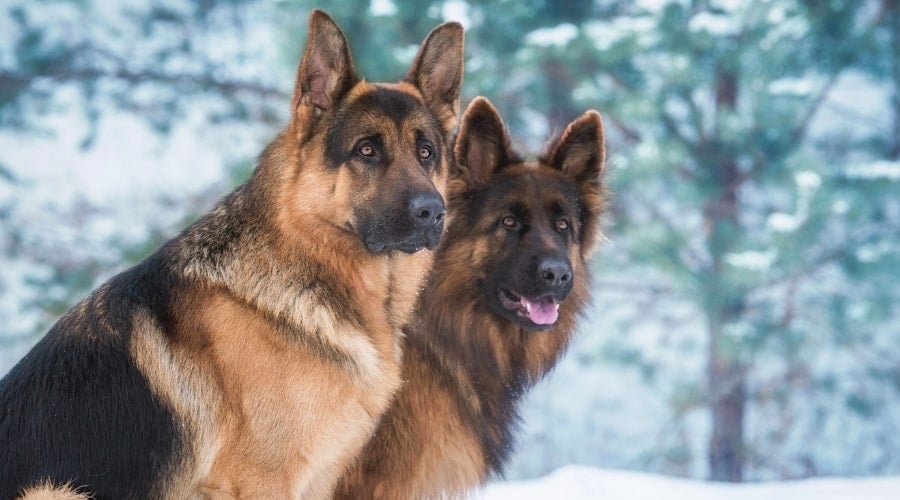
The German Shepherd, also known as the GSD, is probably the world’s most recognizable service and protection dog. However, despite his name, not many people know that he was first trained in ‘Shephard School’ rather than Police Academy. The Germans engineered the GSD in the 19th Century by breeding the best sheep-herding dog from each district.
During the First World War, the GSD was also used to deliver supplies to the German Soldiers. Immediately during and just after the war, his popularity declined due to being associated with the German Nation, and his name was changed to Shepherd Dog by the Americans, and the British referred to him as the Alsatian. In 1931, the AKC reverted his name back to the GSD.
During the latter part of the 20th Century, the GSD became popular again in America when he began appearing in pop culture, such as “Rin Tin Tin’, I am Legend, as well as many other police films. The GSD is still the most popular military and police service canine choice globally.
Appearance
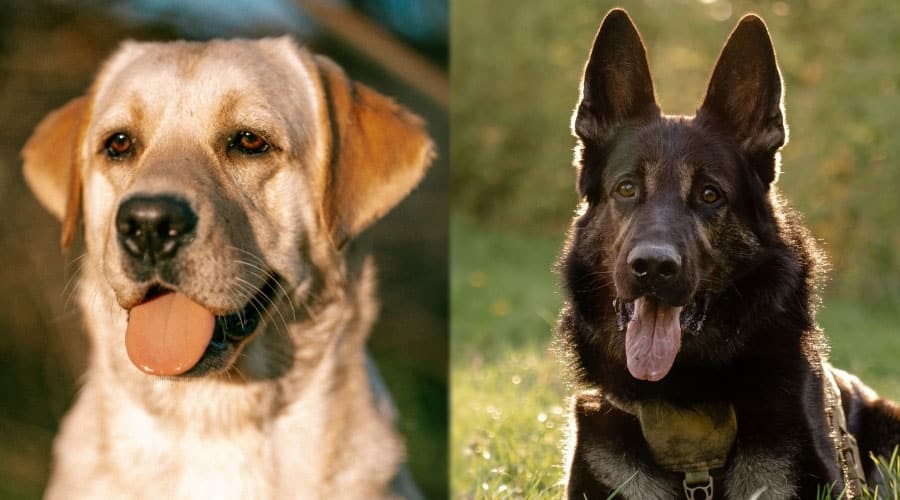
The GSD and the Labrador are almost completely different in their appearance. The one similarity they have is their size. The GSD is slightly taller by a few inches and measures up to 26 inches from paw to shoulder, whereas the Labrador reaches 24.5 inches.
The GSD is also slightly weightier, with its maximum average weight being 90 pounds, whereas the Labrador is 10 pounds lighter. To put that in perspective, 10 pounds is the average weight of a holiday turkey.
The GSD comes in 11 recognized color varieties, whereas the Labrador Retriever comes in three colors. The GSD is most famous for its black and tan color, and the Labrador is most famous for its yellow color.
The GSD’s outer coat is of medium length, versus the Labrador’s outer coat, which is short. They share the same dense undercoat, which protects them from the elements when originally working in the field or the water in the Labrador’s case.
The GSD’s muscles are defined. He is longer than he is tall, and it is this that gives him a more powerful and stronger look compared to that of the Labrador. The GSD’s long gait is also what gives him his speed and ability to rugby tackle any criminal in his way.
A Labrador is also sturdy in appearance, but he does not share the GSD’s authoritative aura. The Labrador appears far more approachable and friendly for those who do not know either breed.
The GSD puppy is quite famous for his large and floppy ears that are way too big for his head, and the countless number of videos online is something you should definitely check out. He does, however, eventually grow into his ears, but he is no less gorgeous. Once the GSD has matured, his face gives an impression of intelligence, whereas the Labrador maintains his happy and super smiley expression into adulthood.
Temperament
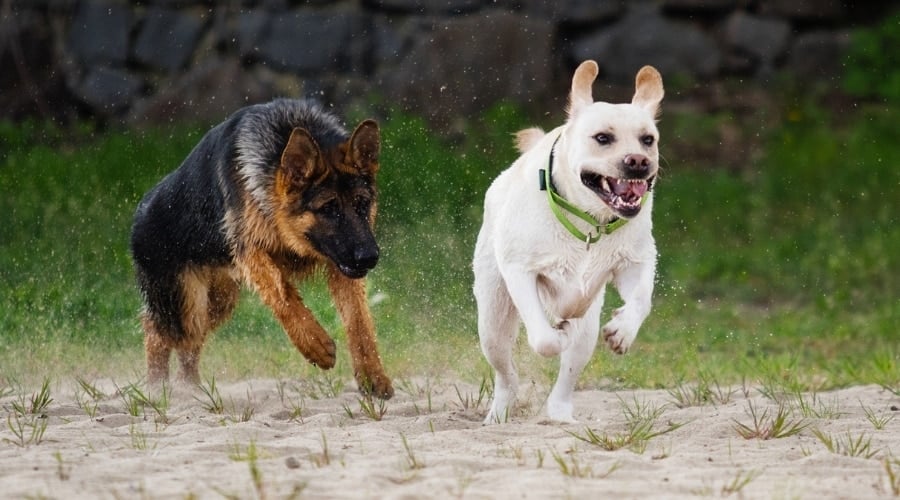
Surprisingly, the GSD and the Labrador are more similar in their temperament than most people think. The main similarity between them is that they both live to serve and please their master, which makes them intelligent and trainable.
They will always be at your feet and join you in the most mundane tasks when no one else will, such as taking out the trash or cleaning the windows. This is a slightly different contrast when comparing the GSD with the Golden Retriever.
The GSD is known to be more of a “one-man” dog in that his loyalties are clearly seen with the one he regards as his main master or caretaker. Often compared to other herding breeds, German Shepherds are quite intelligent and prefer to have a job to do.
The Labrador tends not to be as picky, and his loyalties will lie with whichever family member gives him the best belly rubs at that particular time.
They are also very sociable and love nothing more than muck around with the family and join in with all of the games. If they are both appropriately socialized from a young age, they are also great with small children and other animals. This is one reason that makes them both so popular as family pets.
Because they are such sociable creatures, they can both suffer from separation anxiety if left on their own for too long, so be sure to tire them out before you leave them and leave them with a treat-filled puzzle toy.
Where they do differ the most is that the German Shepherd is naturally more protective of his family and will warn and alert you to any strangers or danger that he feels is coming your way.
The Labrador is not particularly protective and is actually more likely to play with intruders than chase them away. This also means that the GSD is more likely to bark than the Labrador and will let you know if he is suspicious of something or someone.
Exercise
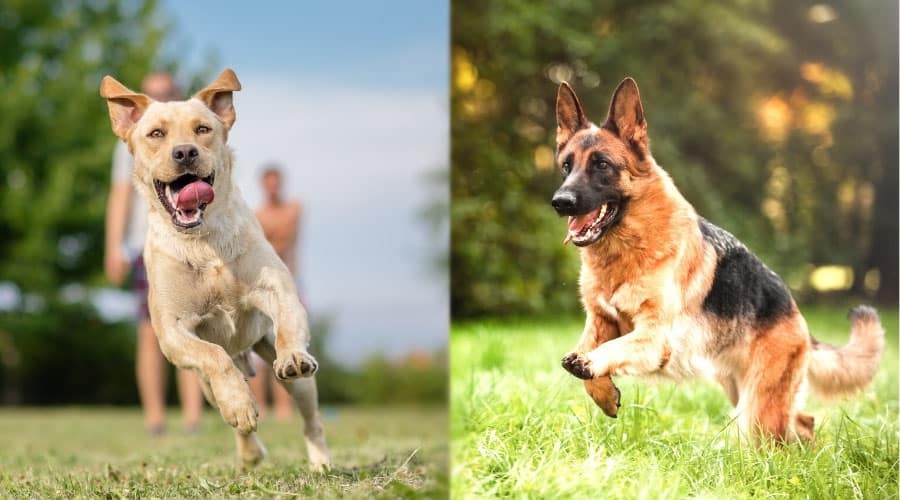
When it comes to the energy of the German Shepherd vs. Labrador, the GSD has a medium energy level. Compared to that of the Labrador, which is high. The GSD needs around 30 to 60 minutes of exercise a day. A GSD will happily play for a few rounds of the ball on top of his daily walking but is also happy to mix it up with a few naps throughout the day. After all, he must preserve his energy to protect his family on night duty.
The Labrador is much more energetic and boisterous and often doesn’t grow out of his puppy phase for at least three years compared to the GSD, who matures at around 18 months.
Not only will he need at least 60 minutes of exercise a day, but he will also need regular interaction with his humans in the form of playing fetch or tug-of-war. If left for too long, the Labrador will become bored. He will start to destroy your possessions and act out with bad behavior in a bid to entertain himself. You may get a cuddle or two if you’re lucky enough to tire him out.
Training
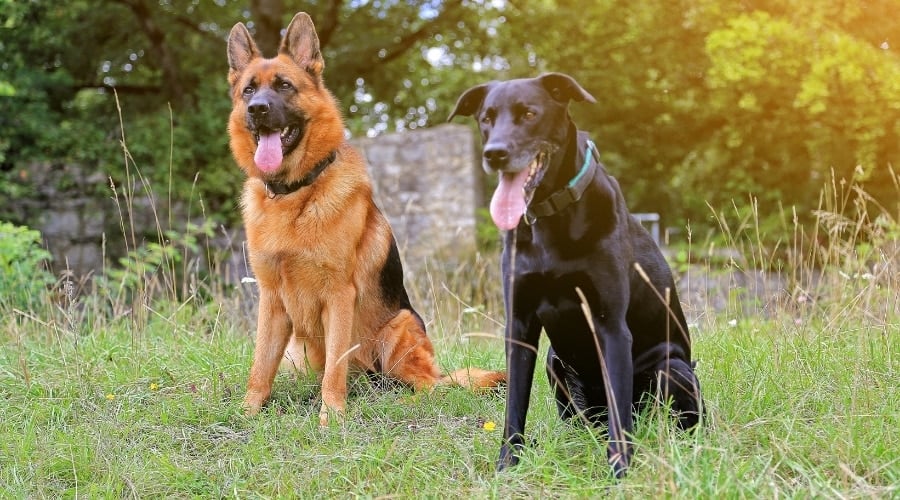
Both the GSD and the Labrador are incredibly intelligent and eager to please their master. Their smarts make these two dogs a dream to train. This is the predominant reason why the GSD is used in military and protection services. The Labrador often works as an assistance dog as well as in search and rescue. Not only do they pick up commands super quickly, but they remember them, too.
Of course, it is important to socialize all pups from a young age. Because the GSD has natural protection and guarding tendencies, it is particularly important for him. The GSD needs to know from a young age that most other humans and animals are okay and not a threat to him or his pack.
The only way this can be achieved is through socialization, and positive reinforcement training makes this process much easier. Rewarding him with plenty of verbal praise and a small treat will ensure that he will want to do it again soon.
Health
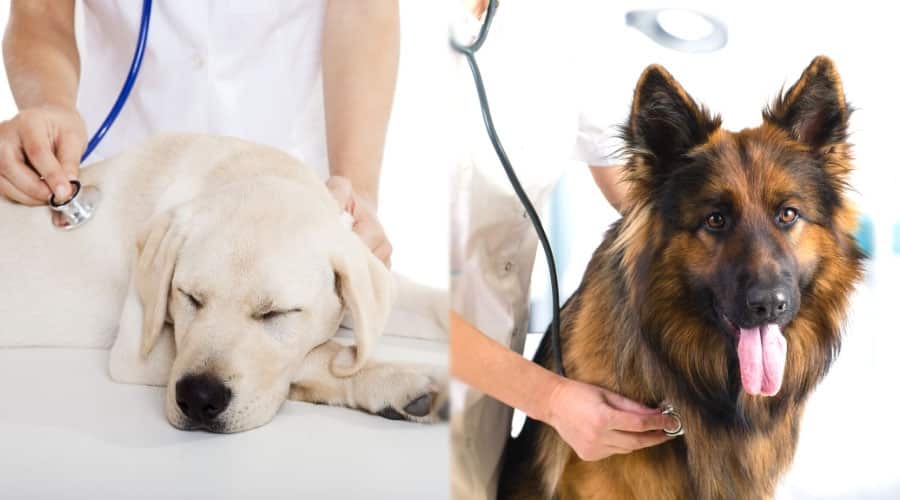
The German Shepherd has a shorter expected lifespan, just 7 to 10 years. Labradors live longer, on average, 10 to 14 years. The health of the GSD is average compared to other breeds, and he is required to be tested for fewer health issues compared to that of the Labrador. The National Breed Club for the GSD recommends testing this guy for hip and elbow dysplasia. An abnormal formation in the joints of the elbow and hip, and over time can cause painful joints and crippling arthritis.
A new health issue that has appeared within the GSD community is that they have developed issues with their back. It is believed that this health issue has been created by breeders purposely breeding GSDs with a slope in their back in order to make them look more streamlined and powerful, but this has only caused these pups difficulty and pain when they walk. Thankfully, reputable breeders would not breed the GSD in this way.
The health of the Labrador is also average. The National Breed Club for the Labrador recommends the following health tests for him:
Hip and Elbow Evaluation
An evaluation of the joints of the elbow and hip to look for abnormal formation can cause painful joints and crippling arthritis.
Ophthalmologist Evaluation
This is an evaluation of a range of eye issues that the Labrador is known to suffer from. For example, progressive retinal atrophy (PRA) is common amongst Labradors, and this is the degeneration of the retina, which, over time, can cause vision loss. Cataracts are also quite common in Labradors.
Exercise-Induced Collapse DNA Test
EIC is where the dog can suffer a loss of muscular control after excessive exercise. In very rare cases, the dog can die immediately, but normally, the episode will last up to 25 minutes. Symptoms include dragging their limbs behind them while they are running, collapsing, and being totally unable to move.
The best way to optimize your pup’s health is to research reputable breeders, and then when you meet them, ask to see the parents and their health certificates as described above and to see the conditions in which all the dogs are living. This way, you know that your pup is healthy and has had the best possible start in life.
Owners of both the Labrador Retriever and German Shepherd may want to consider pet insurance as it can help with the financial costs during emergencies or illness.
Nutrition
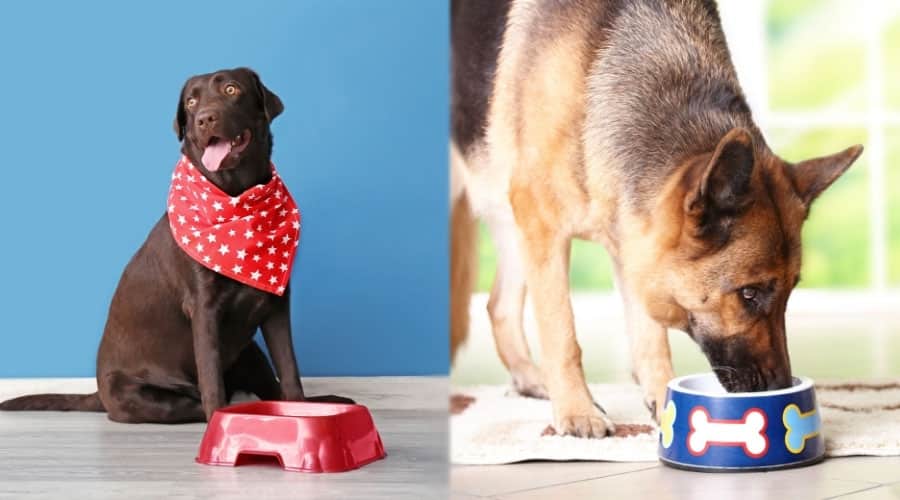
Despite being the least energetic of the two breeds, the GSD will require 3 to 4 cups of food daily, whereas the Labrador will require slightly less at 2 to 3 cups daily. The reason is that the GSD has a higher metabolism than the Labrador, so he needs more food to keep him going.
However, the Labrador will eat whatever he can get his paws on, scavenging and begging for food all day. He is one of the most food-orientated hungry hounds around and can quickly become obese if you don’t monitor his food intake, so it’s really important that you do.
A high-quality kibble and a low-calorie diet suit these pooches down to the ground. Firstly, because they are prone to hip and elbow dysplasia, a low-calorie diet can help to prevent this as much as possible. Secondly, (mainly for the Labrador) lower calories means he is less likely to develop obesity. And, of course, higher-quality food means your pup is getting all the nutrients that he needs to stay healthy and away from his most hated fiend, the Vet.
Scientists have recently discovered the reason why Labradors love treats so much, and that is because the part of their DNA that tells them when they are feeling full, the POMC, is missing. So, ultimately, they are forever hungry.
Grooming
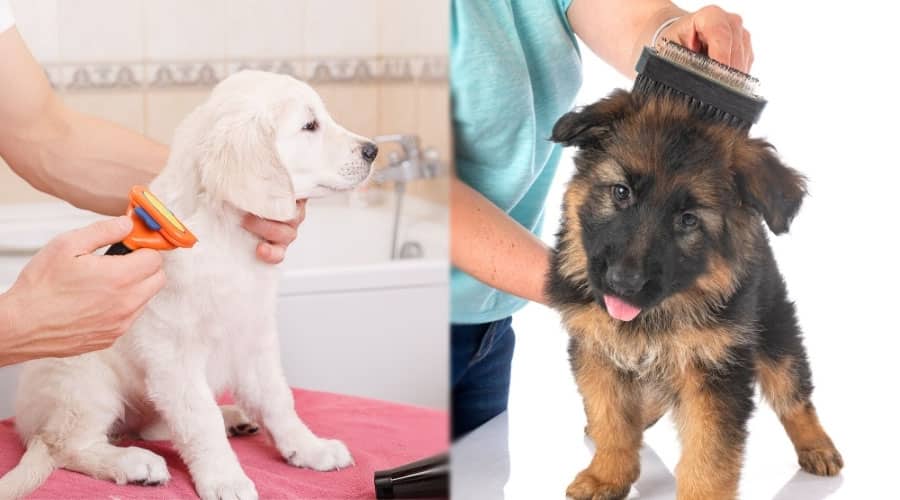
The GSD has a straight, medium-length outer coat with a dense undercoat. The GSD is a heavy shedder, and therefore, you should brush him 2 to 3 times a week to keep his coat manageable for both him, yourself, and your household. The Labrador is also quite a heavy shedder, not quite as much as the GSD, but he should still be brushed 1 to 2 times a week to keep his fur manageable.
Both of these guys should be bathed every 6 weeks. Don’t wash them any more than this. Otherwise, you risk damaging their natural coat oils, which can lead to skin problems. Because they both have a very dense undercoat, be sure to rinse and dry them thoroughly after bathing. If they are left damp, this can cause irritation to their skin.
Price
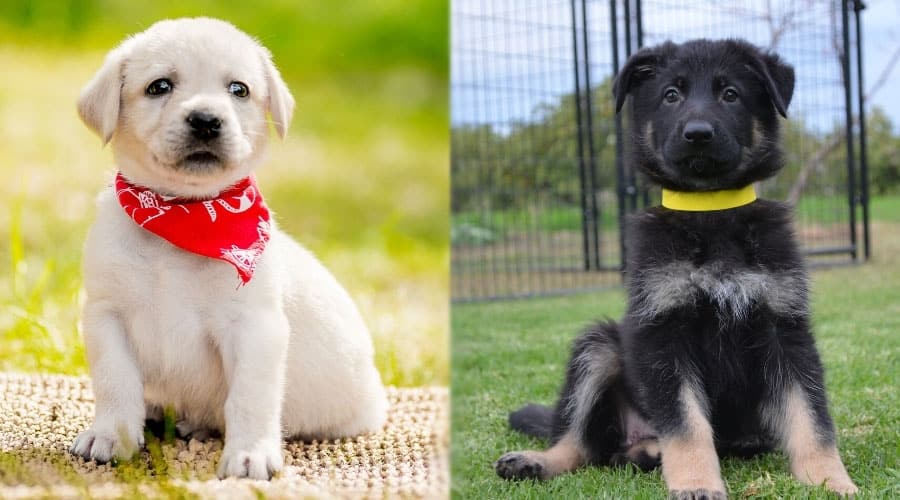
The GSD will cost, on average, between $1,000 and $1,500 from a reputable breeder, whereas the Labrador will cost between $850 and $1,200. The GSD is slightly more expensive because these guys are used for working purposes more so than the Labrador, and therefore, breeders can charge at a premium rate. GSDs from a particular bloodline can reach up to $20,000.
The GSD population in rescue centers can be quite high because new owners have underestimated their guarding tendencies and often find them too intense. So, there is a good chance that there will be a GSD in one of your local rescue shelters. Adoption fees can range anywhere from $50 to $350.
It’s a wonderful thing to give a dog a second chance at finding a loving home. Remember that you can’t always be sure of their previous health history, but if this doesn’t worry you too much, why not be a life-saver?
Final Thoughts
The GSD and the Labrador are both fine specimens of the canine world. They are super intelligent and loving, and there will never be a dull day with these guys around. The Labrador vs. German Shepherd differences are mainly in appearance, health, and guarding tendencies.
They are surprisingly similar in temperament, both sociable and loving. However, if you are after a guard dog, then the GSD would be more suited to you, as the Labrador wouldn’t be any good in this role.
If you still can’t decide on the best pick of Labrador vs. German Shepherd but are still on the hunt for your perfect canine, fear not. You might have an interest in the GSD Labrador mixed pooch, also known as the Sheprador. The best of both worlds comes in this dog-shaped package just so you don’t have to choose between the two.
Ultimately, however, these two canines are both amazing animals and make loyal, loving pets in the right family. You can rest assured that either of these two breeds is a top pick.
